Garvellachs, Eileach An Naoimh
Burial Ground(S) (Early Medieval), Chapel (11th Century) - (12th Century), Church (Medieval), Cruck Framed Barn (18th Century) - (19th Century), Cultivation Remains (Post Medieval), Farmstead (Post Medieval), Leacht(S) (Early Medieval)(Possible), Monastery (Early Medieval), Settlement (Early Medieval), Well (Period Unknown)
Site Name Garvellachs, Eileach An Naoimh
Classification Burial Ground(S) (Early Medieval), Chapel (11th Century) - (12th Century), Church (Medieval), Cruck Framed Barn (18th Century) - (19th Century), Cultivation Remains (Post Medieval), Farmstead (Post Medieval), Leacht(S) (Early Medieval)(Possible), Monastery (Early Medieval), Settlement (Early Medieval), Well (Period Unknown)
Alternative Name(s) Eileach An Naiomh; Tobar Challuim-chille; St Columba's Monastery; Luing; Brandon's Cell
Canmore ID 22361
Site Number NM60NW 1
NGR NM 64017 09724
NGR Description Centred NM 64017 09724
Datum OSGB36 - NGR
Permalink http://canmore.org.uk/site/22361




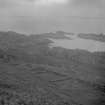








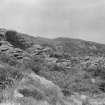



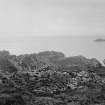

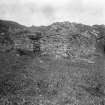






















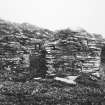







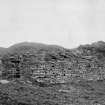










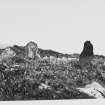





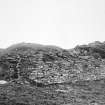









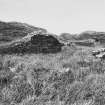























First 100 images shown. See the Collections panel (below) for a link to all digital images.
- Council Argyll And Bute
- Parish Jura
- Former Region Strathclyde
- Former District Argyll And Bute
- Former County Argyll
Project (1927)
The Eileach an Naoimh is the southernmost of a group of islets known as the Garvellachs, or Isles of the Sea, which lie in the mouth of the Firth of Lorne, between Mull in the north and Scarba on the south. Now entirely uninhabited, these islands are inaccessible, not so much from their remoteness as from the fact that they are exposed to the full force of the Atlantic gales which sweep up from the west, often with great suddenness, and the huge seas which break on their rocky shores make a landing impossible. The strong tidal currents also render their neighbourhood dangerous to mariners.
Low on the eastern side, the islands rise to the west, and then drop sheer into the Atlantic in stupendous cliffs over two hundred feet in height. The eastern coasts are thickly beset with skerries whose black fangs spouting with ceaseless breakers warn sailing yachts of the danger of approach. On the landward side of the Eileach an Naoimh several narrow creeks indent the rocky shores and permit of access by small boats in calm weather. The usual landing-place (Fig. 1) is a long narrow inlet called Geodha Chaluim Chille, at the head of which is Columba's Well.
Notwithstanding the stormy and dangerous waters by which it is surrounded, the island was in ancient times the site of a chapel and some sort of ecclesiastical settlement, the remains of which have been happily preserved just because of its inaccessibility. Besides the early chapel there are still extant a beehive hut, an underground cell fancifully called 'the prison’, and various buildings commonly termed the 'monastery’, the 'abbot's house' and the 'hospitium' respectively - a kiln or oast- house and two graveyards, the whole forming a group of structures of much archaeological interest. It was to make an intimate study of these antiquities on behalf of the Society that an expedition was planned and successfully accomplished in the summer of 1927.
The expedition was rendered possible owing to the very kind offices the Rev. Herbert Reid, M.A., M.C., of Port-Glasgow, who generously placed his motor yacht, the Colleen, at the disposal of the exploring party, and conveyed them in person to and from Cullipool in the of Luing. A spell of good weather enabled the skipper to land us, and what was more important, to safely re-embark us on five successive days. We also owed much to Mr. Mackenzie of Cullipool, Chairman of the Parish Council of Luing, who accompanied the party, and whose knowledge of tides and hidden rocks and landing-places was invaluable.
The party consisted of Professor T. H. Bryce, F.R.S., the President of the Society, Rev. G. A. Frank Knight, D.D., F.R.S.E., Mr. C. Calder of the Ancient Monuments Commission [RCAHMS], and Rev. Campbell M. Macleroy, B.D.
Permission for the investigations had been obtained a year earlier from the proprietor, Col. Gascoigne of Craigņish Castle, but when expedition came to be organised it transpired that the structures had been scheduled under the Ancient Monuments Act and our investigations were restricted by the Authorities to a surface examination within scheduled area. The main object then became the obtaining of detailed and accurate plans of the structures. To this end an arrangement come to with the Ancient Monuments Commission in accordance with which they sent one of their staff of investigators, Mr. C. S. T. Calder, to accompany the party, and to prepare a report with plans of the buildings in anticipation of a future inventory of these islands. The expedition was thus made to fulfill a double purpose. The Commission were enabled to compile the inventory of the Ancient Monuments, and they have kindly permitted us to use the plans for the illustration of this paper. We engaged some workmen from the slate quarries at Cullipool and by their aid we removed the bracken and other vegetation in which most of the ruins were largely hidden, and were thus able, without disturbing the surface, to reveal the structures sufficiently to obtain a better idea of their nature, and to permit of Mr. Calder making accurate and complete plans of all of them.
Mr. George Knight, son of Dr. Knight, gave valuable assistance to Mr. Calder in his triangulation of the site, and he and Mrs Macleroy, who also accompanied the party, took many excellent photographic views.
Field Visit (7 April 1970)
As described above. Tobar Challuim-Chille is a natural spring issuing into a basin contained by a large slab.
Visited by OS (AC) 7 April 1970.
Desk Based Assessment (1970)
NM60NW 1 Centred NM 64017 09724
(Centred at NM 640 097) Chapel (NR) (In Ruins)
Cells (NR) (In Ruins)
Burial Ground (NR)
Human Remains found AD 1859 (NAT)
Tobar Challuim-chille (NR)
OS 6" map (1900)
A monastery was established on Eilach an Naoimh by St Brendan of Clonfert in 542, and according to St Columba's biographer, Adamnan, many of the miracles and other incidents in the Saint's life took place not on Iona itself, but at the nearby island monastery of Hinba, which some scholars have identified with Eilach an Naoimh.
Dunbar says the existing remains include two churches, the earlier built of drystone masonry within a cashel-type enclosure, two graveyards, a puzzling complex of domestic buildings, a barn, a kiln, and a double 'beehive' hut, the latter comprising a pair of circular cells which abut against each other and communicate by means of a short passage in the mid-wall. But, he says, it is difficult to assess how many of these buildings belong to the Early Christian period.
Bryce compares the earlier chapel with Irish examples but was unable to examine building 'B' thoroughly and regarded it as a probable chapel. He classified the remaining buildings, including the 'beehive' cells, as being of indeterminate date without excavation, but thought the 'Abbot's House' and kiln to be relatively recent. In 1859 bones and a skull were found when Building 'A' was rebuilt as a sheepfold.
J G Dunbar 1966; T H Bryce and G A F Knight 1933
Information from OS.
Measured Survey (1974)
RCAHMS undertook a series of measured surveys at Eileach an Naoimh in 1974, including:
1. A site plan of the monastery, chapel and settlement
2. A phased plan and section of the beehive cell
3. A plan and section of the underground cell
4. A plan and section of the chapel
5. A plan of the medieval church
6. A phased plan of building F
The drawings were reproduced in ink and published at reduced scales (RCAHMS 1984, figs. 173B, 174A, 176A, 177B, 178D, 179A, 179B
Field Visit (May 1981)
Eileach an Naoimh, the SW island of the Garvellach group, measures 1.9 km from NW to SE by 0.5 km in maximum width and has an area of about 60 ha. To the NW, facing Mull, it presents a sheer cliff-face of metamorphosed limestone, from 45m to 60m in height, from which its surface slopes towards the rocky SE shore. This slope is broken by several elongated rock-outcrops and minor cliffs, interspersed by grassy troughs which show evidence of rig-cultivation. The main group of structures described below is situated in a hollow, sheltered to the W by the highest summit (77m, OD) on the island. The inner enclosure (RCAHMS 1984 A on published plan) lies about 100m N of a T-shaped inlet which at certain states of the tide offers a convenient boat-landing, and from which it is approached by a gully about 10m in width. A low cliff running SW from this gully forms the upper limit of a raised-beach terrace above the boat-landing, on which is situated an outlying enclosure or burial-ground, and on rising ground above this cliff is a small circular enclosure known as 'Eithne's Grave'. Some 80m ESE of the inner enclosure, in rocky ground close to the shore, is a double beehive cell. A natural spring, Tobar Chaluirn Chille ('St Columba's Well'), is situated 30 m N of the boat-landing.
Summary
The earliest remains on the site are the double beehive cell; Eithne's Grave with its associated cross-slab; the inner enclosure (A) together probably with two other transverse walls (Bl, B2) blocking the approach gully; an underground chamber which may represent the remains of another beehive cell; and the upper burial-ground with its associated cross-slab. All of these remains appear to be of Early Christian date, and are probably to be associated with a monastic settlement of the pre-Norse period. The continued ecclesiastical use of the site is shown by the construction in the inner enclosure of a chapel of clay-mortared masonry, which may be attributed to the 11th or 12th century. John of Fordun, writing about 1380, described the island as a sanctuary, and one graveslab of late medieval type is preserved (infra, number 5), while a lime-mortared building standing W of the approach gully is probably a church of the same period. It is possible, but unlikely, that part of a domestic building of this period is incorporated in a complex later structure, traditionally known as 'the monastery' (F). The period at which the SW burial-ground was used is uncertain.
The remaining features described below date from the post-Reformation agrarian use of the island, in the 17th and 18th centuries by a small resident population and thereafter as an outlying part of the farm on Garbh Eileach (RCAHMS 1984 No. 421). They include a corn-drying kiln and winnowing-barn of 18th- or early 19th-century date, an enclosure or stack-yard (E) adjacent to the E boundary of the upper burial-ground, and successive additions to the so-called 'monastery', the last of these being associated with its conversion into a sheepfold in 1859. Two round-angled structures in the SW burial-ground, and others ((7) on the raised beach NW of the boat-landing, may be attributed to the same period.
Eileach an Naoimh first attracted the attention of antiquaries in the first half of the 19th century, and much of the subsequent literature is devoted to the identification, proposed by Skene, with the Columban monastery of Hinba. A number of early photographs, taken by the Revd J B Mackenzie in 1869 and by subsequent visitors (Ireland 1903; Bryce and Knight 1933) provide valuable information about buildings which have since deteriorated or been altered. A detailed and accurate description, with a plan by the late C S T Calder, was prepared in 1927 by a party from the Glasgow Archaeological Society under the direction of Professor T H Bryce (Bryce and Knight 1933). In 1937 the masonry of the beehive cell was consolidated, and some clearance undertaken, particularly in the inner enclosure, by the then Office of Works.
Description
The Beehive Cell.
This substantial double cell is situated 60m from the shore and about 130m NE of the principal boat-landing, from which it was approached by a valley bounded by the rock-outcrop that shelters the cell from the prevailing sw wind. The ground on which it is built falls about 2.3m from NW to SE, and the upper chamber is cut into the slope so that its present floor is about 1.4m below the external ground-level. The building is of figure-of-eight plan, measuring 12-5 m in overall length from WNW to ESE, and a low passage connects the two chambers. Each has an external doorway, but the whole S and E sector of the lower chamber appears to have been rebuilt on a new alignment at a fairly recent date and its doorway belongs to this rebuilding. The original diameter of this chamber was about 4.8m, and of the other 4.1m within 1.5m walls, and the height to the apex of the domed vault that survives over the NW half of the upper chamber is 3.7m.
The cell is built of local flaggy sandstone, mainly in thin slabs, with occasional slabs of Easdale slate. This material is skilfully used in the corbelled vault of the upper chamber, where a smooth internal curve is achieved by oversailing courses and the use of naturally bevelled slabs, but the outer surface is less regular and was perhaps designed to be covered with turf; an external scarcement about 1.4m below the top of the dome may have helped to support such a cladding. Comparison with early photographs shows that the smooth curved wall-face above the external opening of the entrance-passage of the upper chamber is the result of modern restoration, probably in 1937, and the use of lime mortar to point the lintels of the entrance- and linking-passages, some of which were renewed, may be attributed to the same operation. Otherwise no mortar appears to have been used in the construction of the cell. It is probable that, in its original form, the masonry at the entrance extended at least 1m beyond the rebuilt wall-face, where a low footing survives to the W, giving the passage a length of about 2.5m. It measures 1.0m in height and 0.6m to 0.8m in width, while the passage connecting the chambers is 1.1m in height and 0.6m in width. Two vents, each about 0.4m wide and 0.2m high, which penetrate the SW and ENE walls of the upper chamber about 1.2m above floor-level, admitted air and some light and, along with a narrower opening high in the NW section of the vault, may have allowed the use of a fire. The floor-level of the lower chamber is about 0.4m below that of the other.
The internal wall-face N of the passage survives to a height of about 1.5m and preserves the curved section of the lowest courses of a corbelled vault. Although this chamber had the larger diameter, however, its N wall has a minimum thickness of only 1m, and evidently survives to its present height because, like that of the upper chamber, it was set into the slope. The rest of the wall, lacking this abutment, has disappeared, and its materials were no doubt used for the irregular drystone dyke, 1.5m in height, that now forms the S and E perimeter of the chamber. Its doorway has an aumbry in each ingo, and a passage, 0.5m in both width and height, penetrates the E wall at ground level. This may have been a drain to allow use as a byre or, if it was a sheep-pen, an access-passage for lambs.
The Central Area:
The Approach Gully. The mouth of the approach gully lies about 30m N of the well, and the intervening space is flanked to the W by a roughly triangular enclosure (C) bounded on two sides by cliffs. The wall forming the enclosure is fragmentary, and is interrupted at the point nearest the well by the remains of a wall or platform covered in stony debris. This has been identified as one side of an entrance-gate, (Bryce and Knight 1933) but no evidence survives of the other jamb, and the identification is doubtful. The mouth of the gully has been spanned by a wall (B1), represented by scattered boulders, which at each side rose on to a spur of higher ground. About 12m W of the probable opening in this wall, and surmounting a rock-outcrop which interrupts its line, there is a masonry platform (D1) measuring about 3m by 2.5m and 0.8m in height whose surface is covered with quartz pebbles, while a few stones in a corresponding position 16m E of the entrance may be the remains of a similar platform (D2). These two platforms, flanking the entrance and about 2.5m above it, would be conspicuous from the boat-landing, and may have carried cross-bases or served as leachta.
The next cross-wall (B2), 25m N of the first, is represented to the E of the entrance by a few stones of the outer face, and to the why a drystone revetment 1.3m in height which returns N for 13m, flanking a series of slab steps. The third cross-wall (B3), which forms the s boundary of the inner enclosure is a well-constructed drystone wall varying from 1.8m to 2.1m in thickness and containing an opening about 1.1m in width. To the W it is overlain by the so-called 'monastery' (F), while to the E it terminates against a natural slope.
The Inner Enclosure.
This forms a rough pentagon (Simpson 1958) measuring about 35m in greatest span, and bounded to E, NE and NW by higher ground with occasional rock-outcrops. On these sides there are remains of drystone revetment-walls, and it is probable that to the N the level area has been extended by cutting into the slope. The W boundary is a low turf-covered mound about 1m thick, which extends SSE for 12m from the NW angle, but has been obliterated in the level ground beside the 'monastery'. Within the enclosure are several piles of stone, probably the result of clearance by the Office of Works. A larger stone-heap near the NE angle of the chapel may be the result of earlier clearance of the site, or agricultural field-clearance.
The Underground Cell.
This comprises a slab-lintelled inner chamber, about 1.8m in height, and a roofless outer chamber whose floor is about 1.1m below ground level, and which abuts the inner face of the S wall of the inner enclosure. A path paved with large slabs leads from the entrance of the enclosure to a flight of steps giving access to the polygonal outer chamber. An obliquely set stone at the W side of the steps probably marks the entrance-jamb of the chamber, which measured about 2m from N to S by 1.5m transversely. The N wall, which survives to an internal height of 0.9m, shows no evidence of corbelled construction, and it is not apparent how the chamber was roofed. The jambs of the doorway of the inner chamber are modern, but its original lintel remains in situ. At floor-level the chamber is circular in plan, with a diameter of 1.4m, except that the N wall is straight, but the upper part of the W wall also forms a straight chord, and incorporates a well-formed aumbry whose sill projects beyond the curved wall-face below. It is probable that both chambers were used for storage, although the literary references quoted by Simpson show that the suggestion of a penitential use cannot be discounted.
The Early Chapel.
This building stands in the E half of the inner enclosure, and measures 6.6m from E to why 3.6m transversely within walls which vary from 0.85m to 1.0m in thickness and survive to a maximum height of 2.6m. The masonry is composed of long thin slabs of sandy flagstone obtained on the island, with occasional pinnings of the same material, brought to a neat wall-face. A considerable amount of clay survives in the thickness of the wall, and was probably originally used as mortar. The upper part of the N wall overhangs internally by about 0.2m, and this has been interpreted as evidence for a former corbelled vault of Irish type (Bryce and Knight 1933). However, the inner face of the S wall displays only a very slight inclination, and although the well-bonded internal angles show that a slight batter was intended, perhaps to reduce the span for a timber roof, the exaggerated overhang of the N wall was probably due to settlement of the wall-core, increased by the growth of vegetation on the wall-head. The side-walls are, in any case, too thin to support a vault of the suggested height.
The entrance-doorway, at the centre of the W wall, has lost the lintelled head shown in Mackenzie's photograph of 1869. It originally measured about1.9m in height by 0.7m in width, and the lower part of the N jamb is inclined slightly inwards, whereas the upper part is vertical. The only light in the chapel was provided by a flat-lintelled double-splayed window in the E wall, which has a mid-wall width of 0.2m and a height of 0.38m. Immediately S of the window, and level with its sill, a slab 0.35m in projection extends to the SE angle. Like the shelf in a corresponding position on Nave Island (RCAHMS 1984, No. 383) this may have been a substitute for an aumbry, or a support for lamps.
Even before the collapse of the door-head in the W wall, the wall-head level of the end- and side-walls was uniform. However, the side-walls preserve four pairs of sockets for pitched rafters which were probably associated with stone gables, although it is not apparent whether the roof so formed was the original one. An internal bridging slab in the sw angle, and rough sockets in the other angles, suggest that at a later date a hipped roof was constructed, and during the last quarter of the 19th century a rough lean-to shed was built inside the chapel against the E wall. The pavement of small slabs inside the building is probably also connected with recent agrarian use.
Within the Early Chapel is a Medieval Cross:
Upper two-thirds of a tapered slab of slate with bevelled edges, 1.21m by 0.56m broken across and mucg worn. It is bordered by continuous nail-head ornament within a flat moulding. At the right are remains of a sword with curved and inclined quillons and a central fuller, and above the hilt (which has been destroyed), a circle of loose interlace. Most of the surface is filled by intertwined plant-stems forming a vertical series of circular medallions, in imitation of a characteristic motif of the Iona school. (Steer and Bannerman)
The Burial-ground. This is a squarish enclosure situated 40m SW of the inner enclosure and measuring 22m by 25m. Its surface is level, but the W and N boundaries have been cut into rising ground and revetted with drystone masonry. The S wall, about I m in thickness, can be traced curving along the summit of a narrow rock-outcrop, but the E wall appears to have been rebuilt as the w wall of an agricultural enclosure (E), probably of early 19th-century date, measuring about 20m square. Near the E wall of the burial-ground there is a cross-marked grave-marker of Early Christian date (infra, number 2), and near the centre of the enclosure are four square or rectangular stone-built platforms about 0.5m high; that to the NW incorporates a recumbent slab of slate. These platforms seem too numerous to have been leachta, but they may have marked burials.
The Medieval Church. This building occupies a terrace 15m SW of the inner enclosure and immediately above the revetted w side of the approach gully. The main part measures 8.7m from NE to SW by 4.8m transversely within 0.8m walls, reduced to their lowest courses except for part ofthe NW wall, which stands to a height of 2-0m. The masonry of this wall comprises well-coursed rubble masonry bonded in lime mortar, and at the W and E angles there are quoins of Jurassic sandstone, probably obtained from the Carsaig area of Mull. The entrance was at the SW end of the SE wall.
Although the orientation is much further from true E than that of the early chapel, this building appears to be a church of medieval date. Against the NE was an annexe, 4.5m from NW to SE by 3.5 transversely within walls varying from 0.5m to 0.8m. This was probably not a chancel, since no communication appears to have been formed with the church, and such a feature would in any case be unusual in the ecclesiastical architecture of the Western Isles, but it may have been a sacristy, or possibly a post-Reformation burial-aisle. The church was subdivided by a cross-wall, likewise reduced to footing-level, parallel to and 1.8m from the NE wall, but the date and purpose of this alteration are uncertain.
Building F ('the monastery '). This complex structure is situated immediately SW of the inner enclosure, and its SE wall is 2m from the NW wall of the medieval church. It incorporates work of at least four phases, the most recent of which, its conversion into a sheepfold, was undertaken in 1859, when human remains are said to have been discovered. (Ordnance Survey Name Book 18)
The work of the first period comprises a rectangular building measuring 6-8 m from NW to SE by 3.2m transversely within walls varying from 0.6m to 0.85m in thickness, which survive to a maximum height of about 1.9m. The greater part of the SW side-wall was rebuilt, probably in 1859, and the NW half of the opposite side-wall has also been rebuilt, while the NW end-wall is reduced to its lowest courses, so that the only surviving features are two doorways, one towards the SE end of the NE side-wall and the other, which retains its lintel, in the SE end-wall, and an aumbry in the outer face of the SE wall. The SE doorway and the aurnbry served an annexe, 3.1m from NW to SE by 3.5m transversely, whose side-walls form straight joints against the angles of the original block. In both phases, however, the masonry is very similar, being of local flagstone bonded in clay mortar, and the difference may be one of construction rather than date. This range was probably a dwelling, and although a medieval origin, perhaps as a priest's house, is not impossible, it is more likely to belong to the agrarian occupation of the island in the 17th or 18th century.
The rebuilding of part of the NE side-wall of this range, mentioned above, was associated with the addition of a second range at right angles to the first. Roughly built of drystone masonry, it measured about 6.3m from NE to SW by3.3m transversely within walls of irregular width. The greater part of the NE and NW walls has collapsed, and the only surviving features are a doorway and a small opening, probably a window, in the SE side-wall, and a ground-level opening, perhaps a drain, in the SW end-wall. This latter feature may indicate that at this period both ranges were being used to house stock. Their conversion into a sheepfold in 1859 was accomplished by the construction to the SE of a drystone wall enclosing a court about 7m square, with an entrance facing the early chapel, and by building a cross-wall in the NW range. Another cross-wall parallel to and only 0.7m from the NW end-wall of the original range, which was recorded m 1927 (Bryce and Knight 1933) and has since been removed, probably belonged to the same period. A large stone-heap in the courtyard is the result of clearance by the Office of Works.
The Kiln. See Canmore ID 22367
The Barn.
This round-angled building stands in an exposed position at the SE edge of the knoll on which the kiln is situated, some 40m S of the latter. It measures 9.2m from NE to SW by 5.8m over walls about 0.9m in thickness, which survive to a maximum height of 1.8m. Opposed doorways at the centres of the side-walls ensured a through-draught for winnowing. Two pairs of slots in the side-walls formerly held the lower members of the cruck-framed roof, which was probably of hipped form. The drystone masonry resembles that of the kiln, and this building may be attributed to the same period. There are turf-covered remains of a small annexe 2m to the NE.
Other Buildings and Enclosures.
Numerous minor features in the area surrounding the ecclesiastical remains may be attributed to the period of agrarian use. They include three small fragmentary buildings or enclosures (G) in marshy ground at the foot of the cliff NW of the boat-landing, and a small structure with one rounded end (H) on the hillside 40m SW of Eithne's Grave (NM60NW 4). The turf-covered foundations E of the head of the boat-landing (J) are so fragmentary that their nature and period are uncertain.
Short lengths of masonry blocking gullies in the cliff NW of the SW burial-ground were evidently intended to prevent access by sheep, and other turf dykes designed to control stock are found close to the edge of the dangerous NW cliff of the island, and at the head of the valley that runs N from the inner enclosure. This valley, like that running SW from the burial-ground, displays well-preserved cultivation-rigs, and together with the hillside SW of Eithne's Grave these areas probably comprised most of the 5.6 acres (2-3 ha) of arable ground recorded on the island in 1788." A drystone enclosure-wall in the valley NW of the beehive cell was probably used in connection with the landing of stock on the adjacent shore, 17 and a short length of wall abutting the N side of the upper chamber of the cell probably of the cell probably formed part of this enclosure.
Funerary Monuments
Rectangular slab of local flaggy sandstone containig numerous small pebbles, 0.70m in visible height by 0.53m width. On the E face it bears a cross with expanded terminal incised with a wider and deeper groove than that at Eithne's Grave (NM60NW 4). The horizontal and vertical arms are of almost identical length but their intersection is raised a little above the mid-point.
Medieval
Upper two-thirds of a tapered slab of slate with bevelled edges, 1.21m by 0.56m, broken across and mud worn. It is bordered by continuous nail-head omament within a flat moulding. At the right are remains of a sword with curved and inclined quillons and a central fuller, am above the hilt (which has been destroyed), a circle of loose interlace. Most of the surface is filled by intertwined plant stems forming a vertical series of circular medallions, in imitation of a characteristic motif of the lona school.'
Historical Note
The earliest remains on Eileach an Naoimh appear to belong to an ecclesiastical settlement of the Early Christian period which, in such a remote setting, is likely to be a small monastery or communal hermitage. Reeves and Skene, followed by later writers including Simpson, have argued that this was Hinba, one of the principal daughter-houses of lona during Columba's lifetime. (Adamnan {Skene}); Simpson 1958) Of the various objections to this identification, the most cogent is the fact that Eileach, unlike alternative sites such as Jura (cf. p. 27), has retained its pre-Norse name (Watson 1926). A possible connection with another of the great saints of the early Irish Church is suggested by the mention in some texts of the Latin Life of St Brendan of Clonfert of his establishment of a church on the island of Ailech in Britain. He intended to pass the remainder of his life there, but was induced to return to Ireland by a miraculous incident involving two sea-monsters (Plummer 1910). The identification of Ailech with Eileach an Naoimh gains support from the survival in the Garvellachs and adjacent islands of traditional place-names connected with St Brendan, (the name of the highest summit on Eileach itself, not recorded on the OS map, is said to be Dun Bhrennain {Bryce and Knight}, while the adjacent island of A'Chuli appears in older sources as 'Culbrandon' {Brendan's retreat}. Kilbrandon, the medieval parish church of Seil, was also dedicated to St Brendan) but none of the remains described above can be ascribed to a period as early as the 6th century.
Whatever the origins of the ecclesiastical settlement on Eileach an Naoimh, the remains demonstrate its survival into the medieval period, and John of Fordun writing about 1380 described Helant-Leneou as a sanctuary although the church is not mentioned by Monro in 1549. (Chron Fordun, Skene, ed., 1871-2; Munro 1961) In the early 17th century Eileach an Naoimh and A' Chuli were included in the tenandry of Oronsay, as former lands of the priory (RCAHMS 1984, No. 386), and thereafter, along with Garbh Eileach (RCAHMS 1984, No.421), they were held from the Argyll family by a series of wadsetters and tacksmen. The earliest record of a lay population on the island dates from 1637, when two tenants appeared as witnesses to a sasine, but a Presbytery visitation of 1724 left the number of families blank in its report, and Langlands's survey of 1788 does not indicate whether it was still occupied. (Campbell, Argyll Sasines; Kintyre Presbytery Minutes; Langland 1788). When MacCulloch visited the island shortly before 1824 it was uninhabited but grazed by cattle from the farm on Garbh Eileach, whose tenants are said to have use the corn-drying kiln at about that period (McCulloch; Anderson J). The ecclesiastic monuments were placed in the guardianship of the Office of Works in 1926, and the limited conservation described above was undertaken in 1937 (SRO: Ministry of Works Records MW1/645; Murray 1950).
Visited May 1981
RCAHMS 1984
Publication Account (1985)
The journey to the Garvellachs can be an adventure in itself and it is important to choose settled weather. Such a remote island was the ideal choice for a small community of the early church dedicated to a contemplative life. The remains of this period comprise an unusual double-beehive cell, a grave enclosure, and a series of larger enclosures or burial grounds. There is also a church of medieval date. The double beehive cell uses the sandstone slabs of the island to full advantage to form two round chambers within walls which are about 1.5m thick. The slabs of the inner wall faces have been laid in overlapping courses to form a corbelled interior. Each chamber has a doorway from the outside and there is also a passage to provide access between the chambers. The structure has been partly restored in 1937, and it is now difficult to be certain of the original arrangements in some places; the use of mortar appears to date from the reconstruction and would certainly not have been part of the original building-method.
Situated on an elevated position 200m to the south west, there is a circular kerbed enclosure measuring about 3m in diameter with two upright slabs within the line of the kerb, one of which bears an incised cross. This kerbed setting has been traditionally identified as the burial place of Eithne, St Columba's mother.
Other features of early date include a small underground cell, a chapel and a burial-ground, in which there is a cross-marked slab of the type usually described as a grave-marker. Two further crosses are now in NMAS.
Information from ‘Exploring Scotland’s Heritage: Argyll and the Western Isles’, (1985).
Reference (2001)
Early monastery, possibly associated with St Brendan, with inner enclosure, walls spanning entrance-gully, separate burial-ground and double-beehive cell.
(1) Eithne's Grave (see NM60NW 4).
(2) Slab in burial-ground, 0.71m by 0.53m, bearing an incised Latin cross with expanded terminals (NM60NW 1.01).
(3) Slab, 0.62m by 0.22m, bearing on each face an incised Latin cross with expanded terminals (NM60NW 3). (NMS X.IB 167).
(4) Slab-fragment, 0.37m by 0.38m, bearing the head of a ringed cross with sunken 'thistle-shaped' armpits and a central boss, and a superimposed outline cross with square armpits (NM60NW 8). (NMS X.IB 133).
I Fisher 2001.









































































































